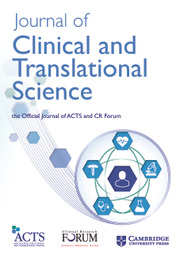No CrossRef data available.
Article contents
578 A guide to successful management of data science collaborative partnerships in academic health centers
Published online by Cambridge University Press: 11 April 2025
Abstract
Objectives/Goals: To design a flexible, comprehensive framework for Data Science Units to cultivate sustainable, long-term relationships with Clinical and Translational Science Research Units. Best practices for managing Data Science collaborations are presented to improve the quality and efficiency of research conducted throughout academic health centers. Methods/Study Population: Leaders of Data Science Units across six institutions formed a workgroup to develop guidance and best practices for Data Science Units to establish long-term, sustainable collaborations with Clinical and Translational Science Research Units. This guidance is based on tools and protocols developed and employed by the participating units, which range from larger groups with over 20 partnerships to a unit with three partnerships that is actively working to expand. Importantly, partnerships are highly variable, with some partnerships at one institution representing engagement with over 500 faculty, whereas some partnerships at another institution involve the lab of a single investigator. Results/Anticipated Results: We offer guidance in three domains: (1) Identifying the needs for a new partnership, including assessing required effort and data science expertise, setting partnership priorities, developing formal agreements, and identifying goals and metrics; (2) managing data science teams by implementing regular meetings, creating project intake and prioritization processes, and effort monitoring; and (3) evaluating the successes and failures/gaps of the collaboration by measuring the metrics mapped to the goals. For each domain, we provide specific suggestions on which parties should be involved and how frequently the processes should occur. This guidance is applicable both to larger collaborative partnerships and to smaller, single faculty or staff partnerships, whether they are new or well-established. Discussion/Significance of Impact: Effective collaboration between data scientists and clinical and translational investigators is key to advancing data-driven research. The guidance and resources are presented to support Data Science Units in successfully managing long-term collaborations through goal-development, evaluation, and adapting to evolving research needs.
Information
- Type
- Team Science
- Information
- Creative Commons
- This is an Open Access article, distributed under the terms of the Creative Commons Attribution-NonCommercial-NoDerivatives licence (https://creativecommons.org/licenses/by-nc-nd/4.0/), which permits non-commercial re-use, distribution, and reproduction in any medium, provided the original work is unaltered and is properly cited. The written permission of Cambridge University Press must be obtained for commercial re-use or in order to create a derivative work.
- Copyright
- © The Author(s), 2025. The Association for Clinical and Translational Science

